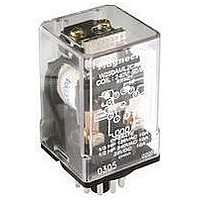755XBXCD-110D Magnecraft / Schneider Electric, 755XBXCD-110D Datasheet

755XBXCD-110D
Specifications of 755XBXCD-110D
Related parts for 755XBXCD-110D
755XBXCD-110D Summary of contents
Page 1
... Magnetic Latching relays can have either single or dual coils single coil device, the relay will operate in one direction when power is applied with one polarity, and will reset when the polarity is reversed dual coil device, when polarized voltage is applied to the reset coil the contacts will transition. AC controlled magnetic latch relays have single coils that employ steering diodes to differentiate between operate and reset commands ...
Page 2
... The Model 712 Series Alternating Relay is designed for duplex pumping systems where it is desirable to equalize pump run time. The solid state alternating circuit drives an internal electromechanical relay. A continuous power source and control switch is required. ...
Page 3
... IEC SET Single Coil (AC) 7/12 (UL 508) Units Resistive Resistive HP HP Pilot Duty Nominal ~ Operations @ Rated Current (Resistive) Unpowered ms ~ Between coil and contact V(rms) ~ Between poles V(rms) ~ Between contacts V(rms) Standard version Storage °C Operation °C Operational g-n g-n grams RESET COIL ...
Page 4
... Other mating sockets see Section 2: 70-750E11-1, 70-750DL11-1, 2.48 (63) 2.95 (75) 3.77 (96) 847-441-2540 Part Number 755XBXC-6A 755XBXC-12A 755XBXC-24A 755XBXC-120A 755XBXC-240A 755XBXCD-6D 755XBXCD-12D 755XBXCD-24D 755XBXCD-48D 755XBXCD-110D – 240A Coil Voltage VAC = 6 - 240A VDC = 6 - 125D 70-465-1, 70-170-1 0.74 (19) 3.77 3.62 (96) (92) OTHER MATTING SOCKETS; 70-750E11-1, 70-750DL11 70-464-1, 70-170-5 7/13 ...








